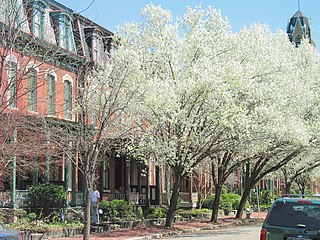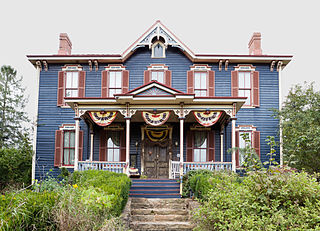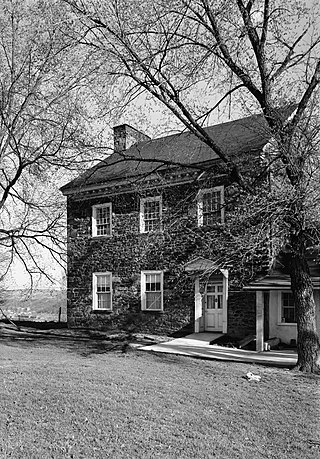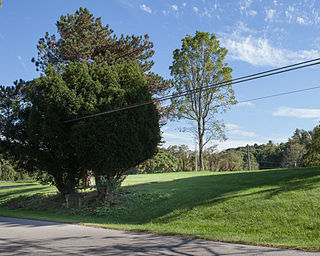
Manchester is a North Side neighborhood in Pittsburgh, Pennsylvania. The neighborhood is represented on Pittsburgh City Council by the District 6. Manchester houses PBF Battalion 1 & 37 Engine, and is covered by PBP Zone 1 and the Bureau of EMS Medic 4. The neighborhood includes the Manchester Historic District, which protects, to some degree, 609 buildings over a 51.6-acre (20.9 ha) area. The district was listed on the National Register of Historic Places in 1975. It uses ZIP code of 15233.

America's 11 Most Endangered Places or America's 11 Most Endangered Historic Places is a list of places in the United States that the National Trust for Historic Preservation considers the most endangered. It aims to inspire Americans to preserve examples of architectural and cultural heritage that could be "relegated to the dustbins of history" without intervention.
The Pittsburgh History & Landmarks Foundation (PHLF) is a nonprofit organization founded in 1964 to support the preservation of historic buildings and neighborhoods in Pittsburgh, Pennsylvania, United States.

Gilfillan Farm is located at the junction of Washington and Orr roads in Upper St. Clair Township, Allegheny County, Pennsylvania, United States. It is a working farm whose current form dates to the mid-19th century.

The Roberts House is a historic building in Canonsburg, Pennsylvania, listed on the National Register of Historic Places. It is designated as a historic residential landmark/farmstead by the Washington County History & Landmarks Foundation. The Greater Canonsburg Heritage Society erected a historical marker near the house, which is the last remaining structure from Jefferson College.

The Sackville House was an historic, American building that was located at 309 East Wheeling Street in East Washington, Pennsylvania before it was demolished in 1980.

The James Thome Farm is a historic farm located in Eighty Four, Pennsylvania. It was designated as a historic residential landmark/farmstead by the Washington County History & Landmarks Foundation, and is listed on the National Register of Historic Places.

The Martin Farmstead is a historic building in Washington, Pennsylvania.

The Thomas Munce House is a historic house located in South Strabane Township, Pennsylvania, United States.

Joseph Dorsey House was a historic building in West Brownsville, Pennsylvania. It is designated as a historic residential landmark/farmstead by the Washington County History & Landmarks Foundation.

Philip Friend House is a c. 1807 historic farm house in North Bethlehem Township, Pennsylvania, US. The stone house is forty feet by thirty feet, two-story, five-bay, and gable-roofed. Contributing outbuildings include a barn, springhouse, wash house, and privy.

Dusmal House is a historic building in Gastonville, Pennsylvania. It is a three-bay, 2+1⁄2-story house built in 1839. A one-story addition was added later in the nineteenth century. The historic significance of the house is as an example of the Post Colonial style of architecture found in Western Pennsylvania. Vernacular builders mixed elements of Georgian, Roman Classical, Adamesque, and European Renaissance styles as they saw fit, differing from traditions in other parts of the country.

The Harrison House was an historic building which was located in Centerville, Pennsylvania.

The Huffman Distillery and Chopping Mill is an historic complex of buildings which is located in Somerset Township, Washington County, Pennsylvania, United States.

Robert Parkinson Farm is a historic property located in Morris Township, Pennsylvania, United States.

Levi Wilson Tavern is a historic building in Buffalo Township, Pennsylvania

Frank L. Ross Farm is a historic building in North Bethlehem Township, Washington County, Pennsylvania, United States.

Washington County History & Landmarks Foundation is a non-profit educational institution in Washington, Pennsylvania, United States. Its purpose is to encourage and assist the preservation of historic structures in Washington County, Pennsylvania. The foundation operates its own landmark certification process, as well as working with the National Park Service to document and place landmarks on the National Register of Historic Places. It also offers advice and assistance for historic building owners who wish to preserve their facilities. Since its inception, the foundation has been successful in helping many historic building owners in the preservation of their structures.

The McCook Family Estate is a historic mansion located at 5105 Fifth Avenue in the Shadyside neighborhood of Pittsburgh, Pennsylvania, USA. It was built during 1906 and 1907 for Willis McCook and his family. McCook was a prominent businessman and lawyer who represented Henry Clay Frick.

The Walker-Ewing Log House is an historic, eighteenth century loghouse located in Collier Township, Allegheny County, Pennsylvania. Owned and managed by the Pioneers West Historical Society beginning in the 1990s, the home and land were acquired by the Allegheny Land Trust in 2020 with oversight responsibility for the building's preservation and easement given to the Western Pennsylvania Conservancy.























